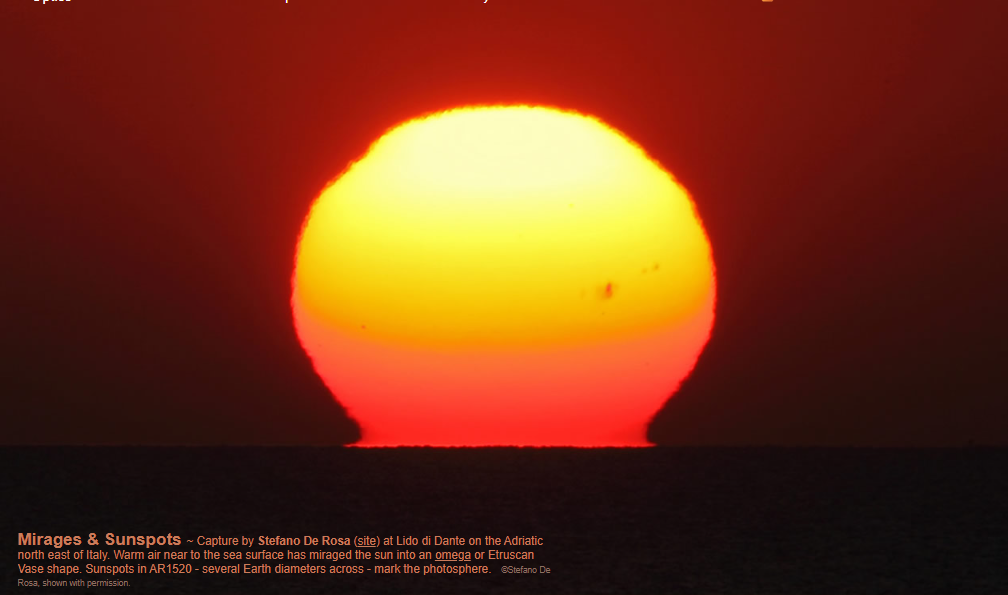OPOD - Suns & Sunspots
OPOD - Suns & Sunspots: Unveiling the Mysteries of Atmospheric Optics
Welcome to a fascinating exploration of atmospheric optics, where we delve into the captivating phenomena that occur in the skies above us. In this article, we focus on a specific atmospheric event - the interaction between the sun and sunspots. Prepare to be amazed as we unravel the mysteries behind these mesmerizing occurrences.
Mirages & Sunspots: A Visual Spectacle
Capturing the attention of sky gazers worldwide, mirages involving sunspots offer a surreal visual spectacle. These extraordinary phenomena occur when warm air near the sea surface distorts the appearance of the sun, creating intriguing shapes. The mirage can transform the sun into various forms, such as an omega or Etruscan vase shape, adding an artistic touch to the sky's canvas.
Sunspots: Markers on the Photosphere
At the heart of these mirages lie the sunspots, which are significant features on the sun's surface known as the photosphere. These dark spots, several times larger than Earth, serve as markers, leaving their imprint on the distorted image of the sun. Sunspots are areas with intense magnetic activity that result in cooler temperatures, causing them to appear darker against the surrounding brighter regions.
Multiple Temperature Inversions: An Illusionary Sunset
Moving across the globe, we encounter another breathtaking occurrence involving sunspots - a mock-mirage sunset. This phenomenon, observed by Jim Grant at Cardiff State Beach in Southern California, showcases the captivating effects of multiple temperature inversions. As light passes through these varying layers of air with different temperatures, it undergoes refraction, creating a sliced and rippled appearance of the sun's disk. In this surreal sunset, a segment of the sun appears almost detached from its base, enhancing the illusionary nature of the event.
Exploring Atmospheric Optics
The captivating interplay between the sun and sunspots is just one example of the wonders that unfold in the realm of atmospheric optics. This field of study encompasses a broad range of phenomena, including rainbows, halos, and atmospheric refraction. By understanding the underlying principles behind these events, we gain insight into the complex interactions between light and the Earth's atmosphere.
Sunspots and Solar Activity
While sunspots contribute to the mesmerizing visuals of atmospheric optics, they also hold significant scientific importance. These dark regions on the sun's surface are linked to solar activity and magnetic fields. Scientists closely monitor sunspots as they provide valuable insights into the sun's behavior and its impact on space weather. By studying sunspots, researchers can better understand solar flares, coronal mass ejections, and other solar phenomena that can affect our technological infrastructure.
The Sun-Earth Connection
The interaction between the sun and Earth extends beyond visual marvels. Sunspots play a vital role in the intricate dance between our planet and its parent star. As solar activity fluctuates, it can influence Earth's climate, satellite communications, and even the power grid. Understanding the dynamics between the sun and Earth allows scientists to make predictions and take necessary precautions to mitigate any potential adverse effects.
Beyond Sunspots: A Universe of Atmospheric Optics
While sunspots are captivating in their own right, they represent just a fraction of the wonders that atmospheric optics has to offer. From iridescent clouds to crepuscular rays, the skies are a treasure trove of breathtaking phenomena waiting to be explored. By venturing into this realm of science, we unlock a deeper understanding of the world around us and the beauty that exists within our atmosphere.
Appreciating Nature's Artistry
As we marvel at the mirages created by sunspots and immerse ourselves in the realm of atmospheric optics, we gain a newfound appreciation for the artistry of nature. The interplay between light, air, and the Earth's surface produces awe-inspiring displays that remind us of the intricacies and wonders of our world. So, the next time you gaze at the sky, take a moment to embrace the beauty that surrounds us and the mysteries waiting to be unveiled in the realm of atmospheric optics.
Exploring Further
If you're eager to delve deeper into the captivating world of atmospheric optics, there are numerous resources available to satisfy your curiosity. Books, scientific journals, and online platforms dedicated to this field offer a wealth of knowledge and insights. Embark on your own journey of discovery and unlock the secrets of the skies above.

Mirages & Sunspots ~ Capture by Stefano De Rosa (site) at Lido di Dante on the Adriatic north east of Italy. Warm air near to the sea surface has miraged the sun into an omega or Etruscan Vase shape. Sunspots in AR1520 - several Earth diameters across - mark the photosphere. ©Stefano De Rosa, shown with permission.

Half a world away Jim Grant captured another miraged sun marked by AR1520 during sunset on the previous day at Cardiff State Beach, Southern California. Multiple temperature inversion layers cause the disk to take on a sliced and rippled appearance with a segment almost detached at its base - a mock-mirage sunset. ©Jim Grant, shown with permission.
Note: this article has been automatically converted from the old site and may not appear as intended. You can find the original article here.
Reference Atmospheric Optics
If you use any of the definitions, information, or data presented on Atmospheric Optics, please copy the link or reference below to properly credit us as the reference source. Thank you!
-
<a href="https://atoptics.co.uk/blog/opod-suns-sunspots/">OPOD - Suns & Sunspots</a>
-
"OPOD - Suns & Sunspots". Atmospheric Optics. Accessed on November 26, 2024. https://atoptics.co.uk/blog/opod-suns-sunspots/.
-
"OPOD - Suns & Sunspots". Atmospheric Optics, https://atoptics.co.uk/blog/opod-suns-sunspots/. Accessed 26 November, 2024
-
OPOD - Suns & Sunspots. Atmospheric Optics. Retrieved from https://atoptics.co.uk/blog/opod-suns-sunspots/.